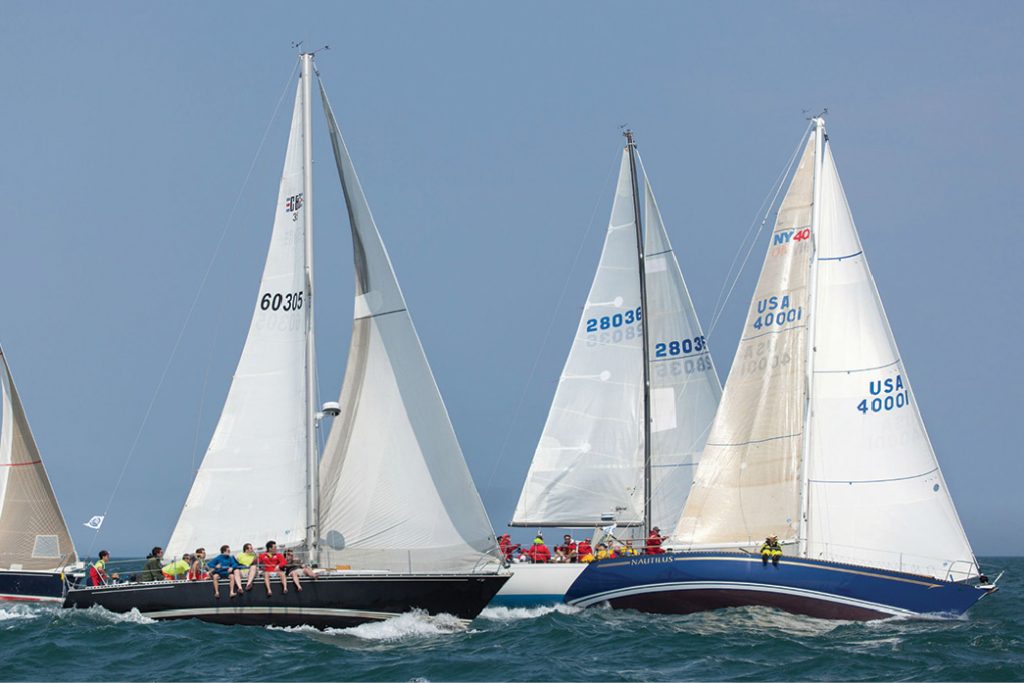By David Dellenbaugh
A number of sailors have asked me to share more ideas about racing in handicap fleets. Here are some thoughts on how to approach a start and the first part of a beat when you are one of the smaller boats in your class:
- Get a copy of the “scratch sheet” for your class. Look to see how many of your competitors are faster than you, and how much faster they’re supposed to be. Find these boats in the starting area so you are sure they’re racing and you know what they look like.
- For the purpose of starting, consider the boats that are only a little bit faster than you as equals. Their slight bit of extra speed shouldn’t make much difference at the start or shortly thereafter.
- Do your pre-start preparation just as if you are getting ready for a one-design race. That is, figure out the wind pattern, sail around the course, work on your speed and check out the starting line. Make up a strategic plan for where you would like to start and go (forgetting about other boats).
- In a handicap fleet, deciding where to start may be even more critical than in a one-design fleet. Picking your spot depends on two things: 1) your strategic plan and 2) the whereabouts of faster boats.
You must balance these two factors against each other. For example, if the line is even and neither side of the course is especially favored, consider the other boats more in your start plan.
If one end of the line and/or one side of the course is very favored, make that your priority and don’t worry so much about other boats. If you start at the favored end, you will be ahead of boats that start down the line, even if you get rolled.
- As you approach the start, keep in mind that smaller boats are usually more maneuverable than bigger boats, and they typically accelerate faster too. Therefore, you will often emerge better from tight situations. Many times bigger boats will hang back a little farther from the line at the start.
- No matter where you decide to start or who is nearby, you should hit the line right at the gun with your boat at full speed. If you do this, it may take a while for even the fastest boats to catch you.
- About three minutes before your start is an important time because a) you should be able to get a good idea of where the bigger boats are going to start; and b) you still have enough time to start wherever you want. A couple of ideas:
- Plan to be in the middle of the line around 3 minutes so you can easily get to either end; and
- If everything else is equal, start to windward of the faster boats (but you must be several lengths away if possible).
- Faster boats also usually point higher, so when you are lining up at the start or looking for a lane after the start, try not to end up just to windward of a faster boat.
- If you have to bail out sometime after the start, it’s better to tack before you are completely rolled by a faster boat. If you wait too long, you won’t have enough speed for a good tack.
- On the other hand, if you are slowly falling into bad air after the start and you will eventually have to tack, it may pay to hold on for a minute or two. If there are starboard tackers that will get in the way after tacking, these boats might pull ahead or fall back after a minute and give you an opening.
- Remember that smaller boats have all the same rights as bigger boats, so don’t get intimidated in tight situations at the start! ■

There are many things we can learn by stepping off our boats, slowing down and getting a better view of the big picture. This is especially true at the start, when boats are crowded together, sailors are often frenetic, and it’s easy to lose sight of the forest for the trees. © Blake Jackson
This article originally appeared in David Dellenbaugh’s Speed & Smarts,The newsletter of how-to tips for racing sailors. If you want to sail faster and smarter, log onto SpeedandSmarts.com.
A resident of Easton, CT, Dellenbaugh was tactician and starting helmsman for America3’s successful defense of the America’s Cup in 1992. He’s a Lightning World Champion, two-time Congressional Cup winner, seven-time Thistle National Champion, two-time winner of the Canada’s Cup, three-time Prince of Wales U.S. Match Racing Champion, and a winner of the U.S. Team Racing Championships for the Hinman Trophy.




